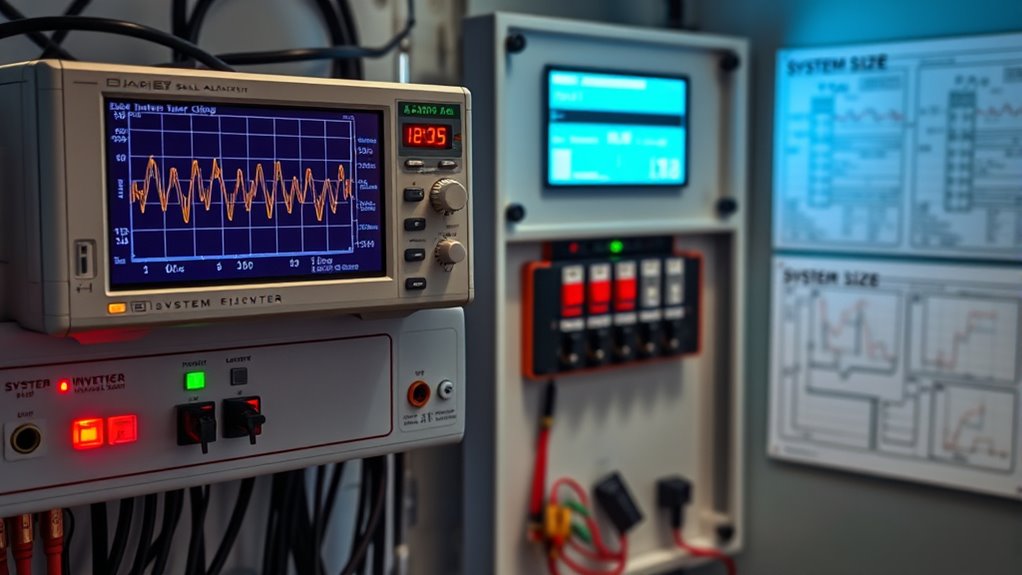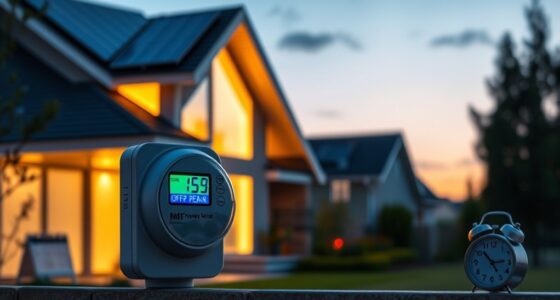Inverter clipping happens when your inverter’s capacity is too small for your solar panels’ maximum output, causing energy to be wasted during peak sunlight hours. To prevent this, you need to size your system properly by matching the inverter to your panels’ highest possible power. Proper system sizing guarantees maximum efficiency and minimizes energy loss. Keep in mind that balancing capacity and cost is key—continue exploring to learn more about optimizing your solar setup.
Key Takeaways
- Proper system sizing ensures the inverter can handle peak panel output, preventing energy waste due to clipping.
- Oversizing the inverter slightly can maximize energy capture but may increase costs without proportional gains.
- Accurate analysis of local sunlight patterns and panel specs is essential for optimal inverter capacity selection.
- Operating an inverter near its maximum capacity improves efficiency, reducing energy loss during peak sunlight hours.
- Balancing inverter size with system costs and performance guarantees consistent, reliable energy production year-round.

Understanding inverter clipping and system sizing is essential for optimizing your solar power system’s performance. When designing your system, one key aspect is guaranteeing that your inverter can handle the maximum power your panels can generate, especially at their Maximum Power Point (MPP). The MPP is where your solar panels produce the highest possible power under specific conditions. If your inverter’s capacity is too low, it will reach its maximum power limit prematurely, causing inverter clipping. This means that during peak sunlight hours, your panels are producing more power than your inverter can convert, and the excess energy gets wasted. To prevent this, you need to size your inverter appropriately, matching or slightly exceeding the peak power your panels can generate without excessively sacrificing inverter efficiency.
Inverter efficiency plays a vital role here. When an inverter operates close to its maximum capacity, it generally maintains higher efficiency levels, making better use of the energy your panels produce. However, if your inverter is undersized, it frequently hits its clipping limit, which reduces overall energy harvest and can lead to inconsistent system performance. Conversely, oversizing the inverter might lead to marginal gains in energy collection but at increased upfront costs and potentially lower efficiency during off-peak times. Striking the right balance involves understanding your system’s expected maximum power output, usually based on your location’s sunlight profile and panel specifications, and selecting an inverter that can handle these peaks without significant clipping.
Proper system sizing isn’t just about avoiding clipping; it also involves optimizing inverter efficiency throughout daily and seasonal variations. A well-sized inverter ensures you maximize energy conversion during the brightest parts of the day and throughout the year. If the inverter is too large, it may operate less efficiently at lower loads, diminishing your overall system performance. On the other hand, an undersized inverter leads to clipping, especially during high-production periods, which wastes potential energy. Additionally, considering bicycle tire longevity in storage can help ensure your entire solar setup remains reliable over time. By carefully analyzing your solar array’s size and expected output, you can choose an inverter that balances capacity and efficiency, minimizing clipping while maintaining high inverter efficiency across varying conditions.
Frequently Asked Questions
How Does Inverter Clipping Affect Overall System Efficiency?
Inverter clipping reduces your system’s overall efficiency by causing power loss during peak sunlight hours. When clipping occurs, your inverter can’t convert all the available solar energy, which means you miss out on potential energy yield. This limitation can lower your system’s performance, especially on very sunny days, making it essential to size your inverter appropriately to minimize clipping and maximize energy output.
What Are the Best Strategies to Minimize Clipping?
To minimize inverter clipping, you should focus on capacity optimization by selecting inverters that match your system’s peak output. Avoid inverter overload by oversizing slightly, ensuring the inverter can handle maximum power without clipping. Regularly monitor your system’s performance and adjust component sizing if needed. This proactive approach helps maintain efficiency, reduces clipping, and maximizes energy harvest throughout the system’s lifespan.
How Does Climate Influence Inverter Sizing Decisions?
Oh, climate considerations are just a minor detail in inverter design, right? Actually, they’re vital. In hot, sunny regions, you need a larger inverter to handle peak power; in colder climates, less so. Ignoring this can cause clipping or system inefficiencies. You should size your inverter based on climate considerations to guarantee peak performance, preventing overloads or underperformance. It’s a simple step that saves headaches down the line.
Can System Upgrades Reduce the Impact of Clipping?
Yes, system upgrades can reduce clipping by increasing inverter capacity or adding battery storage, which helps manage excess energy. Upgrading your inverter guarantees it can handle peak production, while improved battery storage allows you to store surplus energy instead of clipping. Regular inverter maintenance keeps the system running efficiently, preventing performance issues. These upgrades optimize your solar setup, minimize clipping, and maximize energy use, saving you money and enhancing system longevity.
What Are the Cost Implications of Oversizing Inverters?
Oversizing your inverters can increase initial costs due to higher purchase and installation expenses, but a thorough cost analysis often shows long-term benefits. It can improve inverter durability by reducing stress during peak loads, extending lifespan and reducing maintenance costs. However, you need to weigh these benefits against the upfront investment to determine if oversizing aligns with your budget and energy goals, ensuring you optimize both performance and cost efficiency.
Conclusion
Just like a skilled gardener prunes to guarantee healthy growth, proper system sizing and inverter clipping help your solar setup flourish without waste. If you underestimate your needs, you’ll face lost potential—like a river constrained by its banks. Overestimate, and you risk unnecessary costs. Striking the right balance ensures your system operates at peak efficiency, much like a well-tuned orchestra. With thoughtful planning, your solar journey can shine brightly, harnessing energy as naturally as the sun’s warmth.










